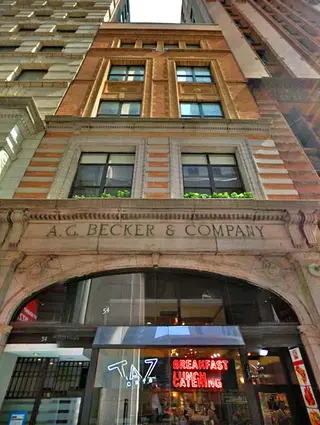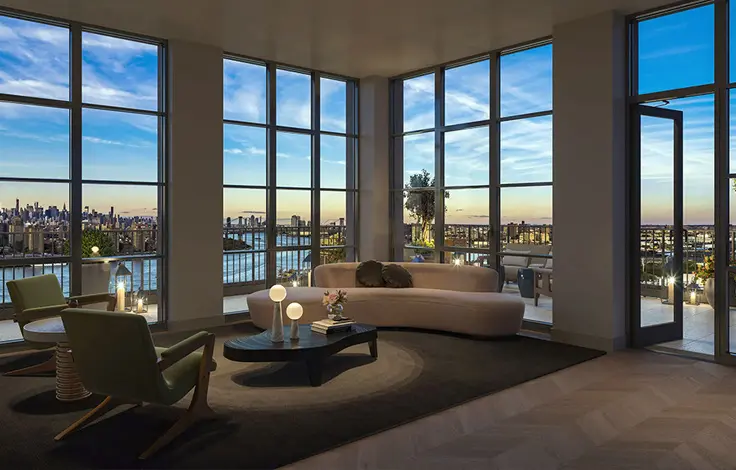 Carter Horsley
Carter HorsleyJan 28, 2020
Carter's Review
This 1907 building at 54 Pine Street between Pearl and William Streets in the Financial District is on the same block as the impressive 1887 Downtown Association Building designed by C. Charles Haight and the magnificent Art Deco skyscraper at 70 Pine Street designed by Clinton & Russell in 1932.
The Fifth Edition of "The A. I. A. Guide to New York City" noted that this handsome low-ris, tan brick and terra cottta building is missing its original cornice but added that "the wide arch framing the entry and the frowning sun motifs in the frieze are intact."
An October 18, 2018 article by Joanne Kaufman in The New York Times noted this building was one of ten cited by Localize.com as one of the darkest apartment buildings (with four or more units) in each of the five boroughs.
"There are those," the article maintained, "who view light as an elemental need, one that trumps everything else, including location, closets, level floors, an elevator, a doorman and proximity to Trader Joe’s. They can now turn for guidance to Localize.city, a website that offers insights — about noise level, speed of snow removal, Citi Bike accessibility, safety for pedestrians, etc., etc. — for every address in New York. Thanks to a specially created algorithm, Localize.city, which was introduced in April, can also tell users precisely how much sunlight hits every side of every building in the city, and how the time of year will affect the quantity of light. In addition, there is information about when during the day the light will be at its brightest, the length of time the light will linger and the way different floors are affected by the shadows cast by surrounding structures."
The building was converted to condominium apartments in 2005.
Bottom Line
An attractive low-rise building with only four units on the same block as the great Art Deco skyscraper at 70 Pine Street and the very handsome Downtown Association.
Description
A lengthy article at Daytonianinmanhattan.blogspot.com January 11, 2018 provided the following commentary about the building that was originally known as the Sun Fire Insurance Building:
"Architect Arthur D. Pickering, whose offices were at No. 105 Fifth Avenue, enjoyed a varied practice in the 1880s and '90s. His commissions ranged from luxurious country homes, to hotels and commercial buildings. In 1889 he was hired by the London-based Sun Fire Insurance Company to design its new New York City offices.
"Established in 1710 the firm was the second oldest fire insurance corporation in the world. (A representative dismissed the second-place designation, noting in 1890 'As a corporation doing a purely fire insurance business it is, however, the oldest, as well as one of the richest.') The firm had branched into New York City in 1882 and by now had 1,500 agents across the United States. Now it looked to replace its old building at No. 54 Pine Street with a modern headquarters.
"On June 7, 1889 Pickering filed the plans. Three weeks later the Record & Guide noted the 27-foot wide building would be 'constructed of Jonesborough granite and light-colored Baltimore brick.' The interiors, said the article would be of 'marble and hardwoods' and there would be one elevator.
"At a time when large buildings were thrown up within months, the Record & Guide seems to have been a bit impatient with the progress three months later. 'The five-story building now being erected at No. 54 Pine street, for the Sun Fire Office, of London, is not far advanced as yet. The first floor iron beams are laid, and the side and rear walls are up to about the third story.'"
"Construction was completed in May 1890 and the trade journal apparently felt it was worth the wait. On May 10 the trade journal said 'Indeed, it is safe to say that this building is one of the handsomest of its kind in the city.' Despite having just five floors, it was a pricey project, costing $160,000 with the land--just over $4 million today.
"...Given the up-to-the-minute design of the upper stories, the ground floor was surprising. The granite piers and entablature echoed the Greek Revival storefronts that had peppered the neighborhood decades earlier The arched openings, as well, were holdovers from a generation earlier.
"The Record & Guide said that much of the high cost of construction was "due to the quality of granite, marble, hardwoods and other embellishments used in the interior. It pointed out "The flooring and wainscoting are of marble, and this is carried through the entire building. Each floor is in hardwood trim, oak and quartered oak being used. There are mantels, mirrors and fireplaces in the private offices of each suite, and all the necessary accommodations for an office building of a fire-class character have been provided, including an elevator, steam heat, electric gas lighting, sanitary plumbing, etc."
"Nearly cartoonish sun faces symbolized the firm's name.
"'Pickering," according to Daytonianinmanhattan.blogspot.com, "produced an eye-catching Queen Anne-style structure with no lack of visually interesting details. Bands of stone contrasted with the Roman brick at the second floor, creating a striped effect. The openings on this level were given egg-and-dart ornamented terra cotta frames.
'"A projecting cornice introduced the third and fourth floors where the openings were unified by a pair of complex Greek key terra cotta enframements. Spandrel panels depicted sunbursts with faces, a nod to the name of the insurance company. The top floor openings were grouped together within elaborate terra cotta frames.
"'In the meantime, The Sun Fire Insurance Company had commissioned architect Richard K. Mosley in 1904 to 'take out and rebuild [the] front wall' and to do interior renovations, including 're-arrange elevators.' While two of the hefty granite pilasters remained, the two openings were replaced by a yawning arch that engulfed a centered window flanked by two entrances, one to the upper floors and the other to the insurance offices. Carved decorations in the spandrels of the arches depicted crossed burning torches--symbols of fire departments and related companies--under a heraldic shield. An incised sunburst, symbolizing the Sun Fire Insurance company provided the background.
'"The corner carvings depict torches, symbols of the fire department, on a sunburst background."
Amenities
The building has a live-in superintendent, an elevator and permits pets.
Apartments
Apartments have central air-conditioning, barrel-vaulted ceilings and exposed brick walls.
'“We don’t get much sunlight here at all, but it doesn’t bother us,' said David Lamer, with his wife, Kristin Karabees, and their daughter, Devon, 15, in the living room of their apartment" according to the Joanne Kaufman article. '“The streets are so tight in Lower Manhattan that there isn’t much sunlight down here at all,' said Mr. Lamer, 54, a technology entrepreneur who has lived at 54 Pine Street since 2006....He and his wife, Kristin Karabees, an executive in the apparel business, wanted a Wall Street-area two-bedroom apartment that exuded character and airiness. The knotty pine paneling, the marble fireplace and the 14-foot ceilings were all they could have asked for. 'I just don’t think you could replicate our space. Ralph Lauren would love it,' said Mr. Lamer, who does have the benefit of a terrace that provides periodic indirect light. 'You enjoy the moment when you get it.'”
History
"By the time the doors opened, the building was fully rented. The basement through second floor were the Sun Fire Insurance offices; the third floor was taken up by the Transatlantic Insurance Company of Germany; the fourth was leased to insurance broker Frederick H. Parson; and the top floor to Joseph S. Spinney, a merchant who did significant business shipping goods to California," according to the Daytonianinmanhattan.blogspot.com.
"Sun Fire Insurance would not be in the building long before it was one agent short. In 1886 the 21-year old Charles Ackerman was hired for $5 a week. The job, a company spokesperson later divulged, 'was procured for him through the influence of H. M. Flagler.' Henry M. Flagler was, of course, a multi-millionaire partner in the Standard Oil Company.
"Ackerman was more interested in enjoying a genteel lifestyle than in working. The Sun later noted 'He lived well and dressed well. His commissioners were very small.' Describing him as 'a tall, good looking young fellow,' the newspaper said that he began courting 'a young lady of good family' in Brooklyn, whom he married in 1890.
"Ackerman's Sun Insurance manager, named Renshaw, told the reporter 'during his courtship Ackerman gave his fiancee expensive presents, and his friends wondered where the money came from.' Everyone involved would find out when the firm's secretary, John J. Purcell, sent a letter to a policy holder in New Jersey asking why he was behind in his premiums.
"The man appeared at No. 54 Pine Street with a receipt for $50 signed by Ackerman. He then headed off for Ackerman's house in Brooklyn. He waited there eight hours until the agent showed up. Ackerman explained that it was all a huge mistake and that the man's money would be refunded the following day.
"The Sun Fire Insurance Company would soon be looking for a replacement agent. The Sun reported on October 21, 1891 that, indeed, he did pay back the $50; 'but things were becoming very warm for him, and he departed to Chicago, leaving his young wife behind him. This was six months ago.' "

- Condo built in 1906
- Located in Financial District
- 4 total apartments 4 total apartments
- 5 recent sales ($1.1M to $1.3M)





 6sqft delivers the latest on real estate, architecture, and design, straight from New York City.
6sqft delivers the latest on real estate, architecture, and design, straight from New York City.
